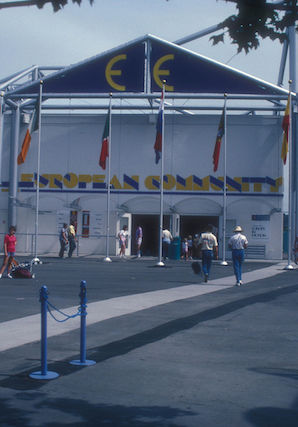Sunday, July 27, 1986.
IT'S NOT A CORPORATION and, although its pavilion sits at the base of Expo 86's European Plaza, it’s not a country. The European Economic Community is, for the moment, an idea in the process of becoming an ever more important reality.
Expo visitors are not entirely sure what to make of it and, as a result, many of them are passing up one of the fair's more informative audio-visual shows. Detailing the drive for European unity, Europe in Motion is an eye-opening look at a superpower in the making.
Founded to encourage “the free movement of people, goods, capital and services,” the EEC brought the democracies of Western Europe together in the development of "common market'' policies in numerous areas. Today, the community's member states co-operate in various combinations in such specialized areas as space exploration, tunnel building and aircraft development.
Projected on a wide, curved screen, the 20-minute presentation is a motion picture flanked on each side by six slide images, each presenting views of a different member state.
The show ends with 12 national flags on view. Then, one by one, the separate banners are replaced by a royal blue flag with a single gold star, eventually resolving themselves into a blue ribbon featuring a row of stars across the front of the theatre.
A show with fascinating content, Europe in Motion is carefully calculated to be a stirring presentation. Its vision of the future, accompanied by the EEC’s official anthem — Beethoven’s Ode to Joy — makes it must viewing for thoughtful fairgoers.
Although the EEC’s show was produced in Germany, it features a British-accented narrator. Coincidentally, the same is true of A Young Generation in Motion, the 17-minute presentation at the West German pavilion.
Designed to underscore the divided nation's human dynamic, it highlights the achievements of musician Ann-Sophie Mutter, actress Nastassja Kinski, the athletes Boris Becker, Bernhard Langer and Martin Cross, and the astronauts Ulf Merbold, Reinhard Furrer and Ernst Messerschmidt as representative of the nation.
Shown on a triptych screen, the presentation links 30 slide projectors with six video presentation systems, a combination that produces as many as 27 images simultaneously. Despite a wealth of equipment, the filmmakers have produced a largely uninspiring travelogue-cum-industrial-documentary-cum-celebrity profile.
The above is a restored version of a Province review by Michael Walsh originally published in 1986. For additional information on this archived material, please visit my FAQ.
Afterword: It seemed like a good idea at the time. Conceived in the aftermath of the Second World War, the European Economic Community was set up in the hope that greater economic integration would bring about a shared prosperity, and that would prevent future armed conflicts. In 1951, six nations (Belgium, France, Italy, Luxembourg, the Netherlands and West Germany) took the first step by signing the Treaty of Paris, the founding document of the European Coal and Steel Community. In 1957, the Treaty of Rome established the European Economic Community (which non-European news media call “the Common Market”), leading to the creation of such institutions as a customs union. In 1973, the membership expanded to include Denmark, Ireland and the U.K. Greece joined in 1981, followed by Portugal and Spain in 1986, just in time to make the EEC’s Expo 86 show a 12-star affair.
History was being made under the 12-star flag the EEC had taken as its own in 1985. That year's Schengen Agreement moved toward an open borders policy. Germany’s reunification in 1990, followed by the dissolution of the Soviet Union in 1991, accelerated the drive for European unity. With the signing of 1992’s Maastricht Treaty, the EEC became the European Union (EU). Austria, Finland and Sweden joined in 1995, swelling the membership to 15. In 1999, 12 of the member states replaced their national currencies with the transnational Euro (although the actual banknotes and coins weren’t available until 2002), achieving one of the dreams of the union’s founding fathers. Missing from the mix, though, was the promised shared prosperity, or a real sense of European identity in the citizens of the member states. The global financial crisis of 2008 made people aware of the runaway growth of social and economic inequality in their countries. That, coupled with a seemingly insoluble refugee crisis and the 2016 decision by the United Kingdom to exit the EU, is seriously testing the institutions celebrated in the EEC’s Expo 86 pavilion.
See also: The eight articles included in this, the third of four Expo 86 special reports, explore the pavilions of:
|
23: Expo 86 EEC/Germany 24: Expo 86 EuroSpace 25: Expo 86 EuroRail 26: Expo 86 Czechoslovakia |
